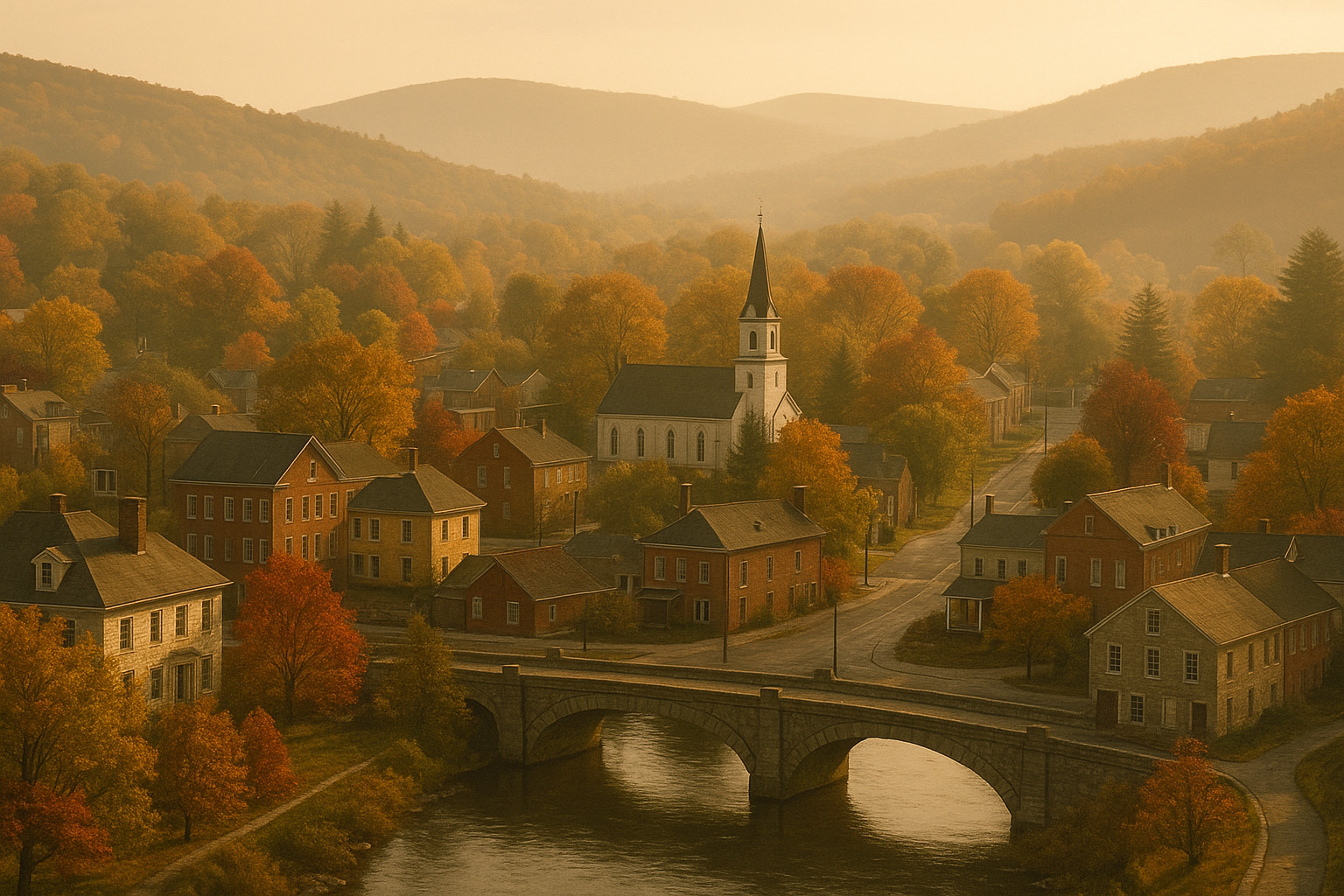
Resin Grove
In the valleys of the Northwest lies a small town, steeped in old rivalries and quiet ambition, where echoes of the past stir the beginnings of something that will one day shape the world beyond it.
Chapter 1
by ![]() Tilfe
Tilfe
In the valleys of the Pacific Northwest, where the mountains curl like sleeping giants and the forests hush even the wind, there lies a town mostly hidden from time. Resin Grove. Small, old, and tucked between shadowed trees and winding rivers, it isn’t the kind of place people move to—it’s the kind of place people are from.
The town rests in a wide basin where the Ashpine River splits the land in two. It’s a slow, broad river with iron-gray water and banks carved from dark stone. That river doesn’t just divide the town—it defines it.
To the east, along the original settlement paths, is the Old Quarter. Homes here lean back on creaking foundations, built from local timber and raised by hands long buried in the town’s graveyard. It's a neighborhood of wraparound porches, wood smoke, and stories told across backyard fences. Cutting through it is a road called Whitlow Street, better known now as Rich Street, because it winds all the way west through the Iron Bridge, and into Ridgewood Heights, the richest neighborhood in town. The Ashbournes own much of it—properties, parcels, names in deeds.
Just above the riverbank in the Old Quarter sits Ashbourne Manor—the oldest intact estate in Resin Grove. Not the biggest, but the most deliberate. Wrought-iron gates, trimmed hedges, gas lanterns that still flicker at dusk. The Ashbournes built their image into the Grove’s bones, and they’ve never stopped polishing it.
Across the bridge, Ridgewood Heights rises up the western slope like a crown. Large homes on wide lots. Gated entries, curved driveways, stone fountains and guesthouses. Some of the properties are older; others gleam with new wealth from jobs in the nearby city. But whether new money or old, everyone here looks toward the lake.
That lake is Eldermere—five miles out and nestled into a private grove of its own. Still, deep, and always cold. It’s not a summer lake. It’s a legacy lake. The Ashbournes own much of its western shore. But across from them, near a ridge choked in pine and silence, stands Hartley Hall.
The Hall was once the pride of Resin Grove—a sprawling estate of dark wood, towering chimneys, and a wraparound veranda that once hosted governors, judges, and foreign guests. Now, it sits in silence. Abandoned, overgrown, and watching. The stone lions at the gate are chipped, their mouths moss-filled. But the bones of grandeur remain. You can feel it in the air: something was here.
Closer to the town’s heart, Mariner’s Hollow spreads out from the south like a quilt—well-kept yards, two-car garages, quiet streets, and porch lights left on out of habit more than need. It’s the middle-class center of Resin Grove. Stable. Comfortable. It doesn’t reach for power like Ridgewood Heights, and it doesn’t cling to memory like the Old Quarter. It just lives.
Further west lies Winder’s Edge, where the mills once turned and trains still pass, though they no longer stop. The houses here sag, some boarded, others patched together with more hope than money. It’s the quiet, rusted end of town—haunted more by memory than malice.
Three lakes serve as the Grove’s liquid boundaries:
Lake Delmere to the north, two miles out, near the edge of the Bridgemont College campus. Its still waters reflect student laughter and dorm lights in the evenings. Some say you can hear music from across it on clear nights.
Jack’s Hollow, to the west, smaller and less polished. A ring of cabins—some used, some forgotten—line its banks. Bonfires spark here in the summers, and secrets settle in its waters.
And Eldermere, five miles south and west, where the air grows quiet, and the trees hold their breath. Eldermere is not where the town plays. It’s where the town remembers.
Beyond Resin Grove, a 30-minute ride by rail or road, is the city of Bridgemont. Founded in the years after World War II, Bridgemont rose with factories, shipyards, and eventually tech companies. It’s Resin Grove’s opposite: newer, louder, brighter. It brought jobs, commuters, outsiders. Resin Grove tolerated it—sometimes resented it—but it gave the old town a reason to keep breathing. People work there, shop there, go to college there. But they return to the Grove to sleep, to think, to endure.
The town never had industry of its own, not in the modern sense. Its economy was once built on timber and resin—hence the name. In the 1800s, the forests gave everything: pine sap for ships, lumber for homes, and wealth for families like the Ashbournes and Hartleys. But the forests thinned, the markets shifted, and only one family adapted in time.
What’s left behind is a town of bones and memory. Roads that creak. Trees that lean as if they’re listening. And shadows cast not by light, but by history.
Resin Grove is not big. It’s not loud. But it holds a thousand years in its soil—some of them proud, some of them buried. The river moves slowly, the fog comes quickly, and the town watches everyone who passes through.
And though many try to forget it… the Grove never forgets them.
Where to next?
Disable your Ad Blocker! Thanks :)
- All Comments
- Chapter Comments